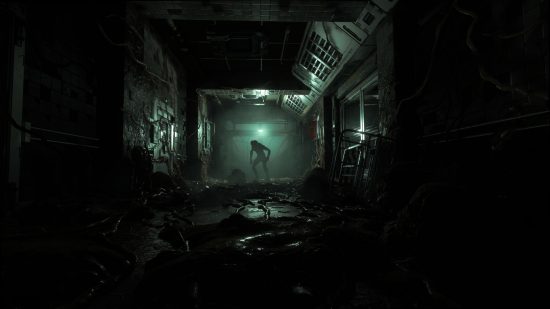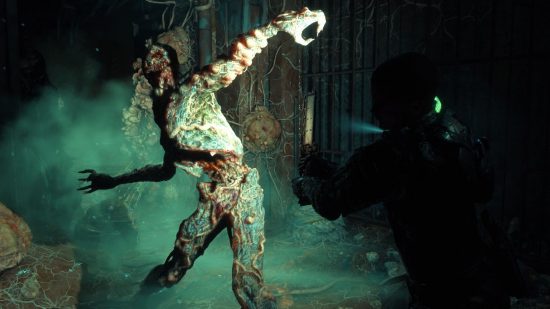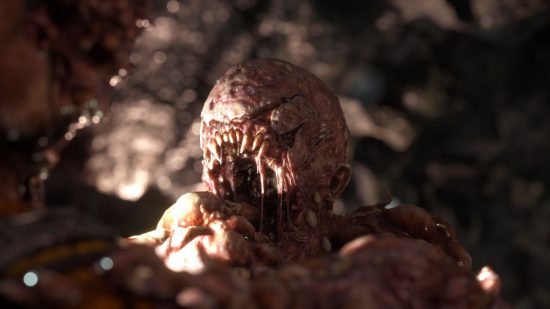Our Verdict
A spiritual successor to Dead Space that blends and riffs on ideas from the best horror games of recent years, with plenty of blood and guts to go around, though a lacklustre plot is its one minor flaw.
Our Callisto Protocol review begins on Callisto – where else? “Oh no,” Jacob says, as a hulking mass of flesh, teeth, and tentacles lurches towards him, and I can’t help but agree. His time in Black Iron prison has not been going smoothly; in fact, it’s been one setback after another while making his escape through a horde of mutated prisoners, guards, and colonists. He’s also undergone his fair share of grisly deaths along the way (sorry, Jacob) and my dwindling ammo suggests he’s about to endure another.
The Callisto Protocol is the first outing for Striking Distance Studios, and with Glen Schofield at the helm, it’s got a lot of expectations riding on its shoulders. Admittedly, it’s easy to fall into the mindset that you’re playing Dead Space. The Callisto Protocol’s certainly got the basics down: a third-person sci-fi action horror, complete with diegetic health bars and kinetic powers. However, it’s by no means a simple clone, and there are even several homages to other games that’ll spark joy in the twisted hearts of seasoned horror fans. A flooded area flirting with the threat of movement below the surface evokes Amnesia: The Dark Descent, and the spectrum of mutations includes a blind foe that tracks sound, emitting a series of distinctive clicks as it lurches through the dark. Sound familiar?
This is a game that does take itself seriously, but not too seriously. There’s a degree of playfulness lurking behind the horror that’s reminiscent of a fright night experience. Yes, The Callisto Protocol wants to scare you, but it also wants you to have fun. This manifests in the form of a pipe emblazoned with ‘Caution!’ appearing in your eyeline only moments before a jumpscare, or a grisly tableau of dismembered bodies in a blood-spattered corridor directly below a poster requesting colonists to ‘Keep This Area Clean!’. Jacob’s death animations are also delightfully ridiculous, an explosion of viscera that adds levity without detracting from the overall tone. In one such animation, Jacob’s arm is ripped off, and blood spurts dramatically out of his stump until the scene fades to black. It’s all bloody disgusting, and more than a bit silly, but it’s also very self-aware.
While it might make you squeamish, there’s no denying that Callisto and Black Iron are gorgeous to look at. The grim industrial beauty of the prison is suffused with flickering lights and glistening gore, and its environments feel organic and functional. Thankfully, the game includes a photo mode with options to adjust the camera and lighting to your heart’s content. That said, while its environments are arresting in some respects, they’re strikingly passé in others. Rather than drawing me in, the repeated ominous graffiti – often written in blood – served to break my immersion and led me to ponder the shortage of pens in a sci-fi prison. This posthumous advice is also a massive tell for what’s about to come next, deflating the moment-to-moment tension during the descent into the bowels of Black Iron.
If you’re partial to horror games, I don’t need to tell you that headphones are essential. Black Iron’s rich soundscape is typified by the unsettling clanking of the prison’s structure, the whir of machinery, and Jacob’s own movements. All these ambient noises are complemented by a soundtrack that shifts from quietly eerie to explosively jarring whenever the moment calls for it. This aural vibrancy is diminished sans headphones – let’s face it, disembodied whispers don’t have the same impact when they’re coming from your monitor.
Unsettling atmosphere aside, keeping an ear out in Black Iron has a practical purpose, too. You can pinpoint enemies making their way towards you through vents, and predict where they’ll pop out. The combat system encourages you to get up close and personal with the biophage, heedless of any instinct to keep them at arm’s length. These close-quarter brawls are highly cinematic, the camera moving in close to inject a claustrophobic urgency into every enemy encounter.
You can expect to come up against truly fearsome biophage mutations, but even grunts hit like a truck; just a few hits can trigger a death sequence. You do have a block which reduces the damage you take a fraction, but dodging is the way to go if you’re looking to preserve your health. These timed dodges force you to be more methodical in your approach, rather than mindlessly mashing the melee button. There’s no timing window here, it’s just a case of getting out of the way before your foe makes contact with your face.
The stun baton is the only melee weapon available – if you’re not counting a rusty crowbar – but it has a satisfying weight to it, and the meaty thwacks of each successful hit never grow stale. The hand cannon is the first actual gun you acquire, and it mirrors Dead Space’s beloved plasma cutter in both its reliability and capacity to become one of the best weapons in your arsenal once fully upgraded. Heavier munitions crop up later in the game, and the culmination of their upgrades grant you access to alternate fire modes.
Dead Space fans may be reassured that you don’t need to cut off any limbs to dispatch the biophage, but there are tentacles – lots of them – which burst forth from their abdomen after they’ve taken a few whacks. You only have a matter of moments to shoot at them before the biophage takes over, mutating into a stronger form that forces a sense of urgency and prevents combat from becoming routine. It’s also pretty grim to watch.
In terms of utility, the GRP glove is a boon for exploration. It operates in much the same way as Dead Space’s kinesis, granting you the ability to drag supplies towards you that are otherwise inaccessible and call the bluff on enemies that try to play dead. It’s also a powerful tool in combat – there’s no better crowd control than yeeting your enemies into a meat grinder.
On that note, The Callisto Protocol does an exceptional job of balancing horror and action, and manages a deft tonal shift towards the latter at the point of the game’s third act. Once you’re kitted out with a complete arsenal, The Callisto Protocol gives you ample opportunity to really cut loose with all that firepower while keeping its horror elements intact.
Unfortunately, The Callisto Protocol’s narrative is a bit of a letdown. It’s very paint-by-numbers; all the major story beats are pulled straight from the library of sci-fi horror tropes, and while there’s comfort to be had while walking this well-trodden path, the plot strays too far into the predictable. It’s also chock full of moments that directly echo what we’ve seen in Dead Space – we won’t spoil anything, but there are some very obvious parallels to make. It’s certainly not a bad story, but it is unremarkable, and its predictability means its various twists and turns lack the punch I crave from a story-driven horror game.
Calling The Callisto Protocol uninspired is incorrect; on the contrary, it wears its many inspirations boldly on its sleeve. Rather, The Callisto Protocol is a celebration of the best horror games of the previous generation, including Dead Space. It excels at what it sets out to do, which is deliver a rollicking good ride with plenty of scares along the way, and it takes clear pride in its heritage. During the game’s denouement, a line of dialogue seems to address me directly: “I do hope you’ve enjoyed your stay at Black Iron.” I’m gratified to say that I have, and I’ll certainly be making a return to The Callisto Protocol again in the future.



